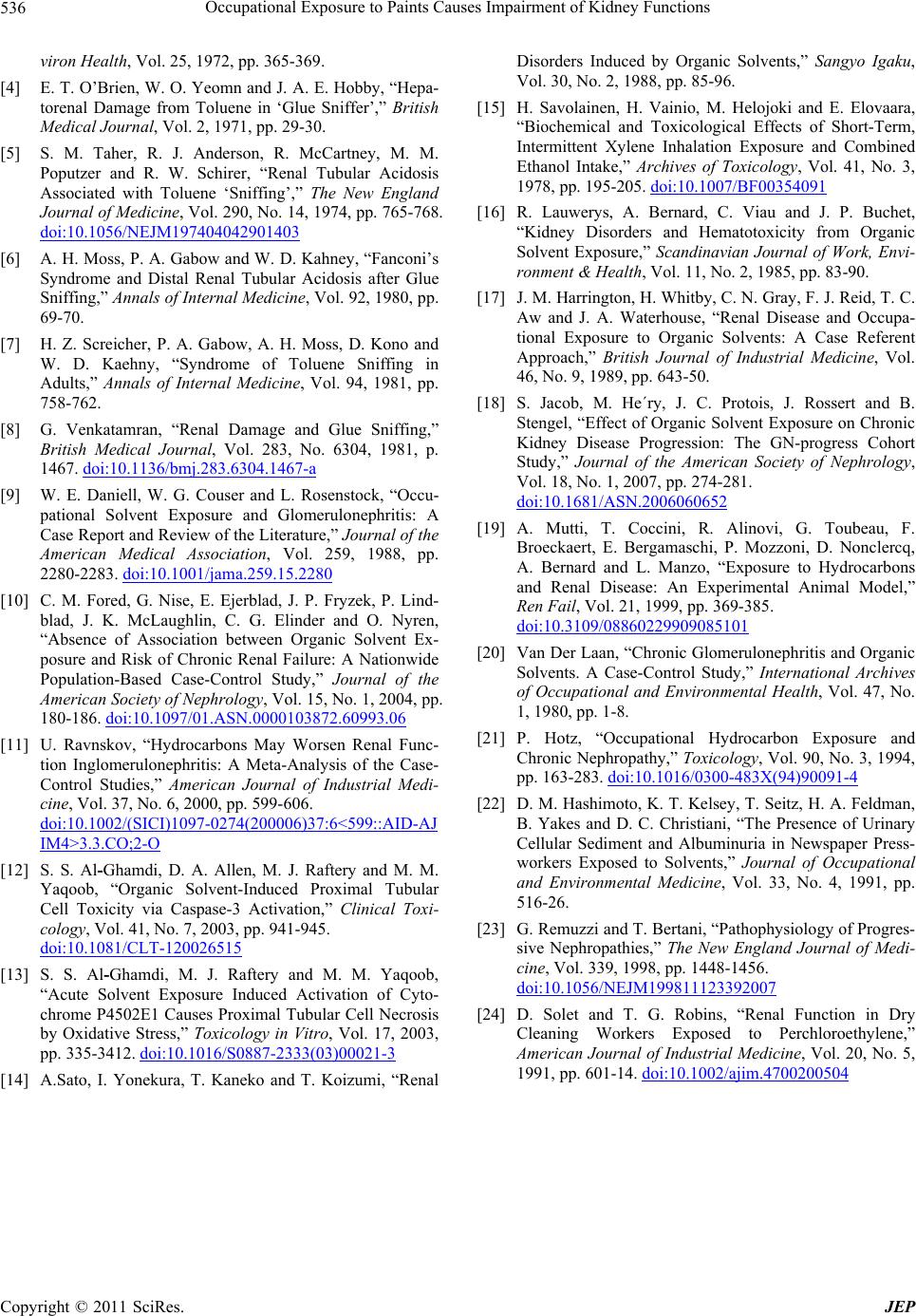
Occupational Exposure to Paints Causes Impairment of Kidney Functions
Copyright © 2011 SciRes. JEP
536
viron Health, Vol. 25, 1972, pp. 365-369.
[4] E. T. O’Brien, W. O. Yeomn and J. A. E. Hobby, “Hepa-
torenal Damage from Toluene in ‘Glue Sniffer’,” British
Medical Journal, Vol. 2, 1971, pp. 29-30.
[5] S. M. Taher, R. J. Anderson, R. McCartney, M. M.
Poputzer and R. W. Schirer, “Renal Tubular Acidosis
Associated with Toluene ‘Sniffing’,” The New England
Journal of Medicine, Vol. 290, No. 14, 1974, pp. 765-768.
doi:10.1056/NEJM197404042901403
[6] A. H. Moss, P. A. Gabow and W. D. Kahney, “Fanconi’s
Syndrome and Distal Renal Tubular Acidosis after Glue
Sniffing,” Annals of Internal Medicine, Vol. 92, 1980, pp.
69-70.
[7] H. Z. Screicher, P. A. Gabow, A. H. Moss, D. Kono and
W. D. Kaehny, “Syndrome of Toluene Sniffing in
Adults,” Annals of Internal Medicine, Vol. 94, 1981, pp.
758-762.
[8] G. Venkatamran, “Renal Damage and Glue Sniffing,”
British Medical Journal, Vol. 283, No. 6304, 1981, p.
1467. doi:10.1136/bmj.283.6304.1467-a
[9] W. E. Daniell, W. G. Couser and L. Rosenstock, “Occu-
pational Solvent Exposure and Glomerulonephritis: A
Case Report and Review of the Literature,” Journal of the
American Medical Association, Vol. 259, 1988, pp.
2280-2283. doi:10.1001/jama.259.15.2280
[10] C. M. Fored, G. Nise, E. Ejerblad, J. P. Fryzek, P. Lind-
blad, J. K. McLaughlin, C. G. Elinder and O. Nyren,
“Absence of Association between Organic Solvent Ex-
posure and Risk of Chronic Renal Failure: A Nationwide
Population-Based Case-Control Study,” Journal of the
American Society of Nephrology, Vol. 15, No. 1, 2004, pp.
180-186. doi:10.1097/01.ASN.0000103872.60993.06
[11] U. Ravnskov, “Hydrocarbons May Worsen Renal Func-
tion Inglomerulonephritis: A Meta-Analysis of the Case-
Control Studies,” American Journal of Industrial Medi-
cine, Vol. 37, No. 6, 2000, pp. 599-606.
doi:10.1002/(SICI)1097-0274(200006)37:6<599::AID-AJ
IM4>3.3.CO;2-O
[12] S. S. Al-Ghamdi, D. A. Allen, M. J. Raftery and M. M.
Yaqoob, “Organic Solvent-Induced Proximal Tubular
Cell Toxicity via Caspase-3 Activation,” Clinical Toxi-
cology, Vol. 41, No. 7, 2003, pp. 941-945.
doi:10.1081/CLT-120026515
[13] S. S. Al-Ghamdi, M. J. Raftery and M. M. Yaqoob,
“Acute Solvent Exposure Induced Activation of Cyto-
chrome P4502E1 Causes Proximal Tubular Cell Necrosis
by Oxidative Stress,” Toxicology in Vitro, Vol. 17, 2003,
pp. 335-3412. doi:10.1016/S0887-2333(03)00021-3
[14] A.Sato, I. Yonekura, T. Kaneko and T. Koizumi, “Renal
Disorders Induced by Organic Solvents,” Sangyo Igaku,
Vol. 30, No. 2, 1988, pp. 85-96.
[15] H. Savolainen, H. Vainio, M. Helojoki and E. Elovaara,
“Biochemical and Toxicological Effects of Short-Term,
Intermittent Xylene Inhalation Exposure and Combined
Ethanol Intake,” Archives of Toxicology, Vol. 41, No. 3,
1978, pp. 195-205. doi:10.1007/BF00354091
[16] R. Lauwerys, A. Bernard, C. Viau and J. P. Buchet,
“Kidney Disorders and Hematotoxicity from Organic
Solvent Exposure,” Scandinavian Journal of Work, Envi-
ronment & Health, Vol. 11, No. 2, 1985, pp. 83-90.
[17] J. M. Harrington, H. Whitby , C. N. Gray, F. J. Reid, T. C.
Aw and J. A. Waterhouse, “Renal Disease and Occupa-
tional Exposure to Organic Solvents: A Case Referent
Approach,” British Journal of Industrial Medicine, Vol.
46, No. 9, 1989, pp. 643-50.
[18] S. Jacob, M. He´ry, J. C. Protois, J. Rossert and B.
Stengel, “Effect of Organic Solvent Exposure on Chronic
Kidney Disease Progression: The GN-progress Cohort
Study,” Journal of the American Society of Nephrology,
Vol. 18, No. 1, 2007, pp. 274-281.
doi:10.1681/ASN.2006060652
[19] A. Mutti, T. Coccini, R. Alinovi, G. Toubeau, F.
Broeckaert, E. Bergamaschi, P. Mozzoni, D. Nonclercq,
A. Bernard and L. Manzo, “Exposure to Hydrocarbons
and Renal Disease: An Experimental Animal Model,”
Ren Fail, Vol. 21, 1999, pp. 369-385.
doi:10.3109/08860229909085101
[20] Van Der Laan, “Chronic Glomerulonephritis and Organic
Solvents. A Case-Control Study,” International Archives
of Occupational and Environmental Health, Vol. 47, No.
1, 1980, pp. 1-8.
[21] P. Hotz, “Occupational Hydrocarbon Exposure and
Chronic Nephropathy,” Toxicology, Vol. 90, No. 3, 1994,
pp. 163-283. doi:10.1016/0300-483X(94)90091-4
[22] D. M. Hashimoto, K. T. Kelsey, T. Seitz, H. A. Feldman,
B. Yakes and D. C. Christiani, “The Presence of Urinary
Cellular Sediment and Albuminuria in Newspaper Press-
workers Exposed to Solvents,” Journal of Occupational
and Environmental Medicine, Vol. 33, No. 4, 1991, pp.
516-26.
[23] G. Remuzzi and T. Bertani, “Pathophysiology of Progres-
sive Nephropathies,” The New England Journal of Medi-
cine, Vol. 339, 1998, pp. 1448-1456.
doi:10.1056/NEJM199811123392007
[24] D. Solet and T. G. Robins, “Renal Function in Dry
Cleaning Workers Exposed to Perchloroethylene,”
American Journal of Industrial Medicine, Vol. 20, No. 5,
1991, pp. 601-14. doi:10.1002/ajim.4700200504